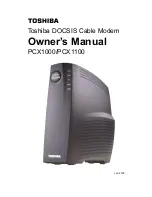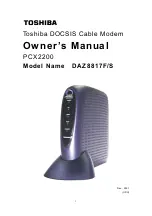
Command Reference Manual
Conexant
1118
4-2
4.1.4 Fax Origination
Origination of fax calls is made using the ATD command. Upon completion of the dial function, a calling tone at 1100 Hz is
transmitted, with a cadence of 0.5 seconds on and 3 seconds off. The modem automatically enters mode +FRH=3 and sends
the CONNECT message to the DTE when FSK flags are detected from the remote.
4.1.5 Fax Answering
Answering of fax calls is identical to answering of data calls with the exception that the modem enters the fax handshaking
mode instead of the data handshaking mode after going off-hook. If +FAE=0, the modem, after sending answer tone,
automatically enters fax mode (+FTH=3), sends the CONNECT message to the DTE, and starts sending FSK flags. If
+FAE=1, the modem determines whether the caller is a data modem or fax modem and sends the DATA or FAX result code,
respectively, to the DTE.
4.1.6 Fax Control Transmission
Fax control transmission is initiated by the +FTH=<mod> command. After this command is issued, the modem generates the
CONNECT message and transmits carrier in the modulation scheme specified by the parameter n. The modem then transmits
HDLC flags for a minimum of 1 second. The modem continues to transmit the HDLC flags until it receives a character from
the DTE.
When characters are received from the DTE, the modem adds start and end flags, performs zero-bit insertion, generates
FCS, and deletes <DLE><chr> character pairs before transmitting the characters to the remote fax machine. Each
<DLE><DLE> sequence is transmitted as a single <DLE>. <DLE><ETX> is considered as the end of frame marker and is not
transmitted. All data received from the DTE after <DLE><ETX> is ignored by the modem until the modem generates either the
CONNECT, OK, or ERROR result code.
If no more data is in the transmit buffer and the final bit was a 1 (bit 4 of the second byte received from the DTE), the modem
generates the OK result code and returns to the command mode. If the final bit was a 0, the modem generates the CONNECT
message and waits for further data from the DTE while transmitting HDLC flags. If no more data is received before 5 seconds
elapse, the modem drops carrier, goes on-hook, and generates the ERROR result code.
4.1.7 Fax Control Reception
Fax control reception is initiated using the AT+FRH=<mod> command. After this command is issued, the modem looks for
carrier in the modulation scheme specified by the parameter n. If no carrier is detected before the period of time specified by
register S7 expires, the modem generates the NO CARRIER message and returns to command mode. If a carrier is detected
that is not the one specified by the parameter n, the modem generates the +FCERROR message and returns to the
command mode. If the specified carrier is detected, the modem generates the CONNECT message and enters the HDLC
receive mode.
In HDLC receive mode, the modem receives HDLC frames from the remote fax machine, strips the flags, performs zero-bit
deletion, performs error checking, and handles <DLE><chr> character pairs before passing the data to the DTE. The modem
prefixes each <DLE> character with another <DLE> character before sending it to the DTE. After the last byte in the frame,
the modem sends <DLE><ETX> to the DTE marking the end of the frame. The modem then generates either the OK
message if no errors were detected or the ERROR message if errors were detected (FCS is incorrect), and returns to
command mode.
While in command mode, the modem continues to receive data in the selected modulation scheme, and sends the data after
sending the CONNECT message to the DTE when the DTE reissues the +FRH command with the same parameter. If the
DTE issues the +FRH command with a different parameter, the modem clears all buffers and proceeds as described
previously.
If carrier is lost while in command mode and the DTE reissues the +FRH command with the same parameter, and there is no
data in the buffer, the modem sends the ERROR result code to the DTE and returns to the command mode. If there is data in
the buffer, the modem sends the next frame of buffered data to the DTE, followed by <DLE><ETX>, and either the ERROR
result code if errors were detected or the OK result code if no errors were detected. The modem then returns to command
mode.
The modem concludes an error is detected if carrier is lost for any period of time during or before the reception of a frame. If
carrier is lost for a time period longer than the time specified by the register S10, the modem finishes delivering the data in the
Summary of Contents for H08-15350
Page 8: ...Command Reference Manual viii Conexant 1118 This page is intentionally blank ...
Page 10: ...Command Reference Manual Conexant 1118 1 2 This page is intentionally blank ...
Page 80: ...Command Reference Manual Conexant 1118 3 62 This page is intentionally blank ...
Page 116: ...Command Reference Manual Conexant 1118 5 22 This page is intentionally blank ...
Page 119: ...INSIDE BACK COVER NOTES ...
















































